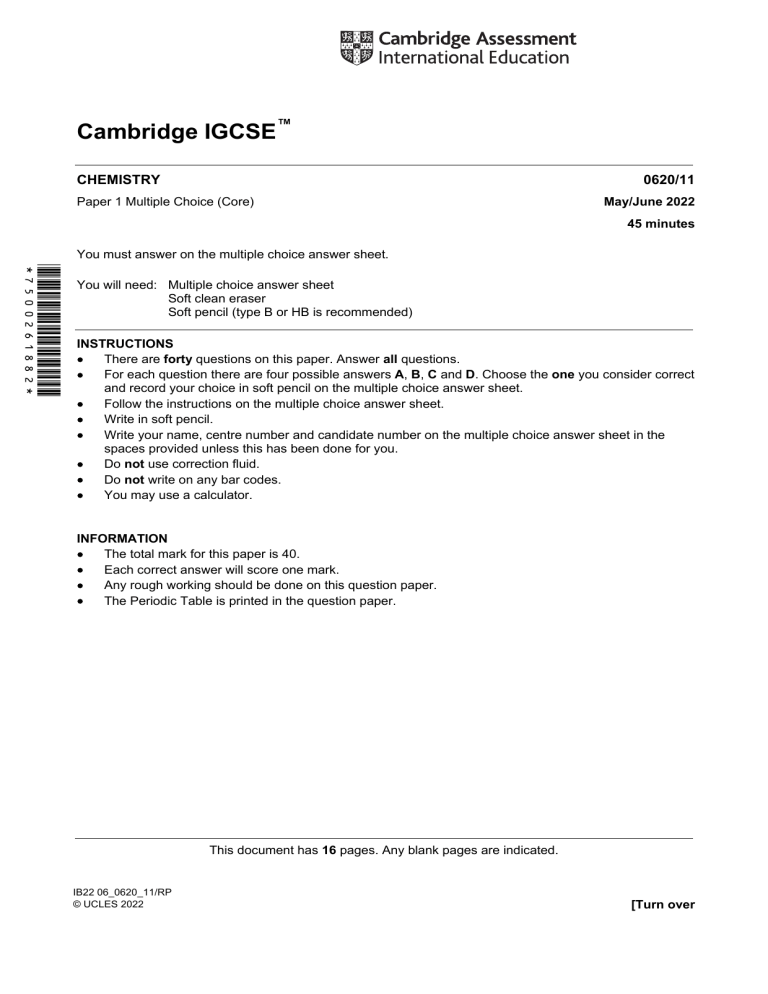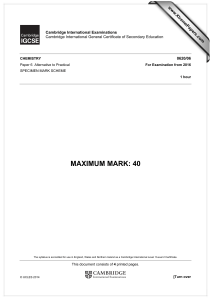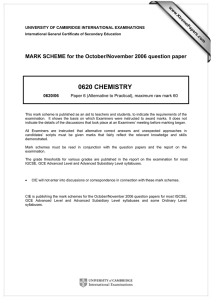
Cambridge IGCSE™ CHEMISTRY 0620/11 Paper 1 Multiple Choice (Core) May/June 2022 45 minutes You must answer on the multiple choice answer sheet. *7500261882* You will need: Multiple choice answer sheet Soft clean eraser Soft pencil (type B or HB is recommended) INSTRUCTIONS There are forty questions on this paper. Answer all questions. For each question there are four possible answers A, B, C and D. Choose the one you consider correct and record your choice in soft pencil on the multiple choice answer sheet. Follow the instructions on the multiple choice answer sheet. Write in soft pencil. Write your name, centre number and candidate number on the multiple choice answer sheet in the spaces provided unless this has been done for you. Do not use correction fluid. Do not write on any bar codes. You may use a calculator. INFORMATION The total mark for this paper is 40. Each correct answer will score one mark. Any rough working should be done on this question paper. The Periodic Table is printed in the question paper. This document has 16 pages. Any blank pages are indicated. IB22 06_0620_11/RP © UCLES 2022 [Turn over 2 1 Diagrams of the three states of matter for carbon dioxide are shown. 1 2 3 Which two diagrams show the states of matter before and after the sublimation of carbon dioxide? A 2 2 to 1 B 2 to 3 C 3 to 1 D 3 to 2 A student measures the time taken for 2.0 g of magnesium to dissolve in 50 cm3 of dilute sulfuric acid. Which apparatus is essential to complete the experiment? A 3 1 stop-clock 2 measuring cylinder 3 thermometer 4 balance 1, 2 and 4 B 1 and 2 only C 1 and 4 only D 2, 3 and 4 Which method is used to separate a mixture of the following liquids? A crystallisation B evaporation C filtration D fractional distillation © UCLES 2022 liquid boiling point / C methanol 64.5 ethanol 78.5 propan-1-ol 97.2 butan-1-ol 117.0 0620/11/M/J/22 3 4 5 6 Which substance should be pure for the intended use? A a drug for curing disease B limestone for iron extraction C petroleum for fractional distillation D water for washing a car Which row identifies an alloy, a pure metal and a non-metal? alloy pure metal non-metal A brass carbon copper B brass copper carbon C copper brass carbon D copper carbon brass Information about the structures of three atoms, X, Y and Z, is shown. atom proton number nucleon number X 1 1 Y 1 2 Z 1 3 Which statements about atoms X, Y and Z are correct? A 7 1 They are isotopes of the same element. 2 They contain the same number of electrons. 3 They contain the same number of neutrons. 4 They contain one occupied electron shell. 1, 2 and 4 B 1 and 2 only C 3 and 4 D 3 only What happens to an atom when it becomes an ion with a charge of +1? A It gains an electron. B It gains a proton. C It loses an electron. D It loses a proton. © UCLES 2022 0620/11/M/J/22 [Turn over 4 8 The relative atomic mass, Ar, of an element is determined by comparing the mass of one atom of the element with the mass of one atom of element Q. What is Q? 9 A carbon B chlorine C hydrogen D oxygen Which equation for the decomposition of calcium nitrate is correct? A Ca(NO3)2 CaO + NO2 + O2 B Ca(NO3)2 CaO + 2NO2 + O2 C 2Ca(NO3)2 2CaO + 2NO2 + O2 D 2Ca(NO3)2 2CaO + 4NO2 + O2 10 The diagram shows the electrolysis of concentrated hydrochloric acid and concentrated aqueous sodium chloride using carbon electrodes. electrode 1 + – electrode 2 electrode 3 concentrated hydrochloric acid electrode 1 only B electrodes 1 and 3 C electrode 2 only D electrodes 2 and 4 © UCLES 2022 – concentrated aqueous sodium chloride At which electrodes is hydrogen produced? A + 0620/11/M/J/22 electrode 4 5 11 Overhead power cables made from (steel-cored) aluminium are used to carry electricity over long distances. Which property of (steel-cored) aluminium makes it suitable for use in power cables? A Aluminium has a low density. B Aluminium has low strength. C Steel is a good conductor of heat. D Steel is resistant to corrosion. 12 Which row identifies a chemical change and a physical change? chemical change physical change A boiling ethanol burning ethanol B burning ethanol evaporating ethanol C dissolving ethanol in water burning ethanol D evaporating ethanol dissolving ethanol in water 13 The equation for the reaction when hydrogen is used as a fuel is shown. 2H2 + O2 2H2O Which statement about this reaction is correct? A Energy is given out so the temperature of the surroundings decreases. B Energy is taken in so the temperature of the surroundings increases. C The reaction is endothermic so the temperature of the surroundings decreases. D The reaction is exothermic so the temperature of the surroundings increases. 14 Which fuels release carbon dioxide when burned? A 1 gasoline 2 hydrogen 3 methane 1 and 2 © UCLES 2022 B 1 and 3 C 2 and 3 0620/11/M/J/22 D 3 only [Turn over 6 15 Water is added to anhydrous copper(II) sulfate. What happens during the reaction? A The copper(II) sulfate turns blue and the solution formed gets colder. B The copper(II) sulfate turns blue and the solution formed gets hotter. C The copper(II) sulfate turns white and the solution formed gets colder. D The copper(II) sulfate turns white and the solution formed gets hotter. 16 Excess magnesium ribbon is reacted with a fixed volume of hydrochloric acid and the volume of gas given off over time is measured. The results of two different experiments are shown. reaction 1 volume of gas given off reaction 2 0 0 time Which statement explains the differences between the results of the two experiments? A Reaction 1 uses a catalyst. B The acid used is twice as concentrated in reaction 1. C The magnesium ribbon is in smaller pieces in reaction 2. D The temperature is higher in reaction 2. 17 Which products are formed when magnesium hydroxide reacts with hydrochloric acid? A magnesium chloride, carbon dioxide and water B magnesium chloride, hydrogen and water C magnesium chloride and hydrogen only D magnesium chloride and water only © UCLES 2022 0620/11/M/J/22 7 18 The oxides of two elements, X and Y, are separately dissolved in water and the pH of each solution tested. oxide tested pH of solution X 1 Y 13 Which information about X and Y is correct? oxide is acidic oxide is basic metal non-metal A X Y X Y B X Y Y X C Y X X Y D Y X Y X 19 An acid is neutralised by adding an excess of an insoluble solid base. A soluble salt is formed. How is the pure salt obtained from the reaction mixture? A crystallisation evaporation filtration B evaporation crystallisation filtration C filtration crystallisation evaporation D filtration evaporation crystallisation © UCLES 2022 0620/11/M/J/22 [Turn over 8 20 Three separate samples of an aqueous compound T are tested. The results of the tests are shown. test observation acidify with dilute nitric acid, then add aqueous barium nitrate white precipitate add aqueous ammonia white precipitate, soluble in excess add aqueous sodium hydroxide white precipitate, soluble in excess What is T? A aluminium chloride B aluminium sulfate C zinc chloride D zinc sulfate 21 Part of the Periodic Table is shown. Which element is a metal? A B C D 22 The elements sodium to argon form Period 3 of the Periodic Table. Which row describes the trend across Period 3 from left to right? number of outer-shell electrons metallic character group number A decreases decreases decreases B decreases increases decreases C increases decreases increases D increases increases increases © UCLES 2022 0620/11/M/J/22 9 23 Lithium, sodium and potassium are elements in Group I of the Periodic Table. Which statement about these elements is correct? A Lithium has the highest melting point and the lowest density. B Lithium has the highest density and the most violent reaction with water. C Potassium has the highest melting point and the highest density. D Potassium has the lowest melting point and the least violent reaction with water. 24 Which statement describes a transition element? A It can act as a catalyst and some of its compounds can also act as catalysts. B It forms white compounds with sulfur, oxygen, chlorine and bromine. C It has a low density and a piece of it will float on water. D It is a very poor conductor of electricity. 25 Which diagram represents the arrangement of the outer-shell electrons of a noble gas? A B C D 26 Which statements about the general properties of metals are correct? A 1 They are good conductors of heat and electricity. 2 They have low melting points. 3 They react with dilute acids to form a salt and water. 4 They react with oxygen to form basic oxides. 1 and 2 © UCLES 2022 B 1 and 4 C 2 and 3 0620/11/M/J/22 D 3 and 4 [Turn over 10 27 Reactions of three metals and their oxides are shown. metal add dilute hydrochloric acid to metal heat metal oxide with carbon 1 key 2 = reacts 3 = does not react What is the order of reactivity of these metals, from most reactive to least reactive? 123 A B 132 C 213 D 231 28 Which uses of the metals shown are correct? aluminium stainless steel A aircraft bodies car bodies B car bodies aircraft bodies C chemical plant food containers D food containers cutlery 29 Which statement about the reactions in the blast furnace is correct? A Carbon reacts with oxygen and heats the furnace. B Carbon monoxide removes the silicon dioxide impurity forming slag. C Iron(III) oxide is oxidised to iron. D Limestone reduces iron(III) oxide to iron. 30 Iron rusts when exposed to air. Which two substances in air cause iron to rust? A carbon dioxide and oxygen B nitrogen and oxygen C oxygen and water D carbon dioxide and water © UCLES 2022 0620/11/M/J/22 11 31 Fertilisers are used to provide three of the elements needed for plant growth. Which two compounds would give a fertiliser containing all three of these elements? A Ca(NO3)2 and (NH4)2SO4 B Ca(NO3)2 and (NH4)3PO4 C KNO3 and (NH4)2SO4 D KNO3 and (NH4)3PO4 32 Which process produces methane? A combustion of hydrocarbons B decomposition of vegetation C respiration D reaction between hydrochloric acid and calcium carbonate 33 Which statements about sulfur dioxide are correct? A 1 Sulfur dioxide decolourises acidified potassium manganate(VII). 2 Sulfur dioxide forms when acids react with carbonates. 3 Sulfur dioxide is used as a bleach. 4 Sulfur dioxide is used to treat acidic soil. 1 and 3 B 1 and 4 C 2 and 3 D 2 and 4 34 What are the products when limestone (calcium carbonate) is heated strongly? A calcium hydroxide and carbon dioxide B calcium hydroxide and carbon monoxide C calcium oxide and carbon dioxide D calcium oxide and carbon monoxide 35 In which lists are the compounds in the same homologous series? A 1 CH4, C2H4, C3H8 2 CH3OH, C2H5OH, C3H7OH 3 CH3CO2H, CH3CH2OH, CH3CH2CH2OH 1 and 2 © UCLES 2022 B 1 and 3 C 2 only 0620/11/M/J/22 D 3 only [Turn over 12 36 Which row about aqueous ethanoic acid and dilute hydrochloric acid is correct? both contain carbon both contain hydrogen both react with carbonates A key B = yes C = no D 37 Some properties of colourless liquid L are listed. ● It boils at 65 C. ● When added to water, two layers form which do not mix. ● It does not react with sodium carbonate. ● It has no effect on bromine water. What is L? A ethanol B hexane C hexene D ethanoic acid 38 A molecule of compound P contains two carbon atoms and four hydrogen atoms. Which row represents P? name of compound Mr reacts with aqueous bromine A ethane 30 B ethene 16 C ethene 28 D ethene 28 © UCLES 2022 0620/11/M/J/22 13 39 The equation representing the reaction of a hydrocarbon with water is shown. catalyst CxHy + H2O CxH5OH What are the values of x and y? x y A 1 4 B 1 6 C 2 4 D 2 6 40 Many molecules of J join together in reaction R to form a long chain molecule K. K is the only product. Which row describes molecule J, reaction R and molecule K? molecule J reaction R molecule K A polymer addition monomer B monomer addition polymer C polymer cracking monomer D monomer cracking polymer © UCLES 2022 0620/11/M/J/22 14 BLANK PAGE © UCLES 2022 0620/11/M/J/22 15 BLANK PAGE Permission to reproduce items where third-party owned material protected by copyright is included has been sought and cleared where possible. Every reasonable effort has been made by the publisher (UCLES) to trace copyright holders, but if any items requiring clearance have unwittingly been included, the publisher will be pleased to make amends at the earliest possible opportunity. To avoid the issue of disclosure of answer-related information to candidates, all copyright acknowledgements are reproduced online in the Cambridge Assessment International Education Copyright Acknowledgements Booklet. This is produced for each series of examinations and is freely available to download at www.cambridgeinternational.org after the live examination series. Cambridge Assessment International Education is part of Cambridge Assessment. Cambridge Assessment is the brand name of the University of Cambridge Local Examinations Syndicate (UCLES), which is a department of the University of Cambridge. © UCLES 2022 0620/11/M/J/22 © UCLES 2022 21 0620/11/M/J/22 calcium 40 38 Sr strontium 88 56 Ba barium 137 88 potassium 39 37 Rb rubidium 85 55 Cs caesium 133 87 22 cerium 140 90 Th thorium 232 lanthanum 139 89 Ac actinium – 231 protactinium Pa 91 141 praseodymium Pr 59 58 Ce 57 – dubnium Db 105 181 tantalum Ta 73 93 niobium Nb 41 51 vanadium V – rutherfordium Rf 104 178 hafnium Hf 72 91 zirconium Zr 40 48 titanium La lanthanoids 57–71 89 yttrium Y 39 45 scandium Ti 23 Cr 24 238 uranium U 92 144 neodymium Nd 60 – seaborgium Sg 106 184 tungsten W 74 96 molybdenum Mo 42 52 chromium relative atomic mass – neptunium Np 93 – promethium Pm 61 – bohrium Bh 107 186 rhenium Re 75 – technetium Tc 43 55 manganese Mn 25 – plutonium Pu 94 150 samarium Sm 62 – hassium Hs 108 190 osmium Os 76 101 ruthenium Ru 44 56 iron Fe 26 27 28 29 30 – americium Am 95 152 europium Eu 63 – meitnerium Mt 109 192 – curium Cm 96 157 gadolinium Gd 64 – darmstadtium Ds 110 195 platinum Pt Ir iridium 78 106 palladium Pd 46 59 nickel Ni 77 103 rhodium Rh 45 59 cobalt Co – berkelium Bk 97 159 terbium Tb 65 – roentgenium Rg 111 197 gold Au 79 108 silver Ag 47 64 copper Cu – californium Cf 98 163 dysprosium Dy 66 – copernicium Cn 112 201 mercury Hg 80 112 cadmium Cd 48 65 zinc Zn B C – einsteinium Es 99 165 holmium Ho 67 204 thallium Tl 81 115 – fermium Fm 100 167 erbium Er 68 – flerovium Fl 114 207 lead Pb 82 119 tin Sn In indium 50 73 germanium Ge 32 28 silicon Si 14 12 carbon 49 70 gallium Ga 31 27 aluminium Al 13 11 boron 6 – mendelevium Md 101 169 thulium Tm 69 209 bismuth Bi 83 122 antimony Sb 51 75 arsenic As 33 31 phosphorus P 15 14 nitrogen N 7 – nobelium No 102 173 ytterbium Yb 70 – livermorium Lv 116 – polonium Po 84 128 tellurium Te 52 79 selenium Se 34 32 sulfur S 16 16 oxygen O 8 – lawrencium Lr 103 175 lutetium Lu 71 – astatine At 85 127 iodine I 53 80 bromine Br 35 35.5 chlorine Cl 17 19 fluorine F 9 – radon Rn 86 131 xenon Xe 54 84 krypton Kr 36 40 argon Ar 18 20 neon Ne 10 4 5 helium VIII 1 VII hydrogen VI 2 V He IV 1 III H The volume of one mole of any gas is 24 dm3 at room temperature and pressure (r.t.p.). actinoids lanthanoids – Ca K – actinoids 20 19 Ra 24 23 radium magnesium sodium Fr Mg Na francium 89–103 12 11 Sc 9 7 name atomic symbol Be beryllium Li lithium atomic number 4 3 Key II I Group The Periodic Table of Elements 16







